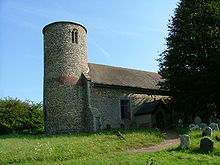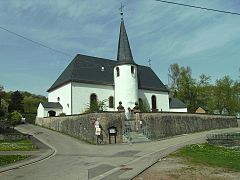Round tower church
Round tower churches represent a special architectural form of church buildings in the western half of Europe, which are particularly concentrated in England.
distribution
Germany
In Germany there are or were round tower churches in the western half.
- Baden-Württemberg ( Achern and Lorch )
- Bavaria ( Heilig Blut in Landshut ; St. Thomas in Augsburg , a modern round tower church that does not actually correspond to the category).
-
Holstein
- Vicelinkirchen in Neukirchen / Malente , Pronstorf and Ratekau and originally in Bosau .
- The Holstein round tower churches also include the Holy Spirit Church (Barmstedt) , St. Johannis (Hamburg-Eppendorf) and the Rellinger Church , whose towers were walled.
- Church in Kaltenkirchen
- Only the swamp of the tower of St. Andrew's Church (Weddingstedt) remains.
- Südschleswig ( Süderstapel , Kosel and Oeversee )
- Lower Saxony ( Suderburg , Betzendorf , Reckenhausen , Salzhausen , Sattenhausen and the west )
- North Rhine-Westphalia ( Lukaskirche in Münster)
- Rhineland-Palatinate (Eckersweiler, Hermeskeil notification)
- Saarland ( Bebelsheim , Erfweiler-Ehlingen and Reinheim ).
England and Orkney
The majority of these churches are found in England , particularly in East Anglia . There are 124 round tower churches in Norfolk alone and 38 in Suffolk . Other counties with at least one round tower church are Essex , Cambridgeshire , Sussex and Berkshire .
The round tower churches in East Anglia are often of Anglo-Saxon origin and some are over 1000 years old. A characteristic of many round tower churches in Norfolk is the thatched roof , a form of roofing often found in the area .
The churches are sometimes far from settlements. The reason for this is that the sovereigns used to relocate their subordinate residents in order to create hunting grounds. The dwellings were demolished and rebuilt elsewhere, but no one dared approach the churches, so that they stand lonely in the landscape and are often only accessible via footpaths.
This results in the problem that many of the churches no longer have any parishes and are either blessed and left to decay or have to be maintained by charitable organizations such as the Churches Conservation Trust, which are financed through donations. A lack of money also often means that the original thatched roofs can no longer be renewed or the churches deteriorate.
The St. Magnus Church on Egilsay ( Orkney ) also has a round tower.
More round tower churches
Other countries with round tower churches are
- Andorra , Santa Coloma
- France (in Alsace - Lorraine Altrippe, Berg, Farebersviller, Farschviller, Heckenransbach, Hilbesheim, Lidrezing, Metting, Rodalbe, Tarquimpol, Uzès , Weyer , Ville-Di-Paraso (Corsica), Xouaxange, Zetting),
- Italy
- Norway
- Poland
- Scotland (St. Magnus Church on Egilsay , Orkney ) and Kilmore church, Dervaig, Isle of Mull, Hebrides
-
Sweden , Blantarps Kyrka, Bollerups kyrka, Hammarlöv kyrka, Hammarlunda kyrka, all in Skåne
Solna kyrka Stockholm - South Africa
- Czech Republic
Bebelsheim Church in Bliesgau
St. Martin in Berg / Alsace , France
Origin theories
The round tower is characteristic of this church shape. It is still unclear why this form was used. There are the following theories on this.
- Many round tower churches - especially in East Anglia - are located in areas where there was little suitable building material. Since it is easier to build round shapes with the existing softer stones, the towers were constructed round. Against this theory speaks that in northern Germany there are many round tower churches made of field stone ( Feldsteinkirchen ).
- Other churches are located in areas that have been subject to frequent looting by Vikings . There is the theory that originally they could have been defense towers . Against this theory, the fact that the towers were usually too short to offer sufficient protection and, moreover, were often only added to existing churches later. This can often be recognized by the fact that the walls of the tower are flat where it is attached to the ship .
- The round towers are explained on a trial basis based on local conditions, such as prehistoric stone circles or fountains. Under the English king Æthelstan , who recaptured most of the land previously occupied by Vikings , the Vikings stayed in their villages. This also applies to villages that have round tower churches. The place name or its suffix is an indication of a Viking foundation. In 937 Athelstan passed a law that established what constitutes a claim to the status of "thegn" (free man) and to his property (see Shakespeare Macbeth , Thane von Cawdor). One requirement was that the country had to have a bell tower (bell). There is evidence that the towers were only erected on existing churches at this time. It is possible that the round towers owe their existence to this ordinance, as many of the round tower churches that have survived date from before the Norman conquest in 1066, and some were built afterwards. Exact records were made in 1086 when the Domesday Book was created as the first land register.
However, a generally satisfactory explanation is still lacking.
Demarcation
Round tower churches are not to be confused with the Celtic round towers, as they are often found in Ireland ( Glendalough ) or less often in Scotland.Neither with round churches , which, in contrast to round tower churches, in which only the tower is round, have a round church floor plan or have a round part of the church.
literature
- WJ Goode: Round Tower Churches of South East England (Round Tower Churches Society); the standard work on the subject.
- Lyn Stilgoe: The Round Tower Churches of Norfolk - Illustrations by Dorothy Shreeve, Canterbury Press Norwich, ISBN 1853114480 .
- Heidi Kügler: Round tower churches in Bliesgau , 1st edition - Neuss 1993., 19 p., Numerous. Ill., ISBN 3-88094-755-4 . - (Ed .: Rheinischer Verein für Denkmalpflege und Landschaftsschutz, series: Rheinische Kunststätten 394: Saarland).












